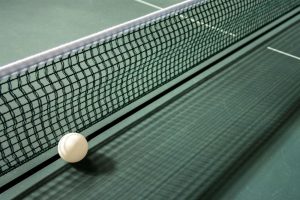- You are here:
- Home »
- Table Tennis
- » How To Install a Table Tennis Net

How To Install a Table Tennis Net
Installing a net for your table is easy if you look for a few easy-to-identify parts and follow some basic, general steps. So let us take a quick look at how to install a table tennis net with ease.
Identifying What You Have to Work With
As one would expect, different tables from different brands use different methods of setup. Luckily for the user, the basics are all very similar and easy to learn and apply to every table you come across.
In most cases, you'll be working with two clamps, a tensioner, and a height adjuster.
These are the standard components when it comes to setting up your net, and this is primarily all that you need. The clamps appear precisely as you would think and are easy to identify how to use.
The tensioner is a specific component that is most commonly in the form of a string or screw. It controls the tension of the net, or how tightly the net is pulled.
Lastly, the height adjuster will likely be a screw of sorts located on the underside of the clamp. It will be attached to the bottom of the net's poles.

Setting Up
Firstly, you'll want to make sure your two halves of the table are aligned perfectly. The clamps often have the dual purpose of attaching these halves, as well as acting as poles for the net.
Aligning the clamps to mirror each other is just as important to the proper setup as attaching the net itself. Once everything is all is lined up, start tightening the clamps until they have a firm grip. They should be unable to move when hit by a served or volleyed ball.
Some designs have the net already attached to the clamps, while others have the two separate. Should your set have the latter, attach the net to the poles found on the clamps you've connected.
The general design includes pockets or holes on each end of the net, which can slide over the poles.
An alternate, but just as popular, design has two poles attached to the sides of the net. These poles slide into hollow poles found on the clamps.
For this design, you slot the net's solid poles into the clamps' hollow poles.
Adjustments
Now that your clamps are secure and your net is attached, you will need to make changes to ensure your table is game-ready. Here is where the previous two components come into play: the height adjuster and the tensioner.
The net serves to create a half-line buffer between players. To have a slack net can cause the ball to bounce or slide over the net. You may as well not even be using a net if you aren't taking the time to adjust it properly for the game.
Often, the height adjuster is a simple screw found on the underside of the poles connecting the net and clamps. Merely turning these clockwise or counterclockwise will allow you to adjust the height of the net.
The net should not come into contact with the table, while still allowing players to hit the ball over the net.
The tensioner will be a simple string that you can pull to tighten the net. Older designs will use a loose line with stoppers.
However, newer models use a system similar to a block-and-tackle or a fishing rod. The former requires merely tugging on the string until you reach the desired tension and then placing the stoppers in the holder.
The stopper could be a groove to slot a bead in or spikes to tie around the slack. The newer systems incorporate the stopper into the pulley itself.
All you need to do is pull to the desired tension and then set it to hold.
Final Thoughts
Having followed all these steps, you'll want to ensure your net is game-ready.
When purchasing a net, you'll likely find a measuring device in the shape of a 'u' or an 'n'. This device must be placed covering the net with the 'feet' to the table.
You'll know if the net is too high should the instrument not be flush with the table. If the net is too low, the device will be leaning while hanging on the net.
Should you not have this device, measure the distance from the table to the top of the net. You're aiming for 15.25cm or 6 inches exactly along the entire top surface.
To achieve this equal distribution of height, you can tighten the net using the tensioner. Make sure you don't over-tighten the net. You can carefully adjust the tension so that the net maintains a 15.25cm/6-inch height across its full length.
Now that you've set up properly, you can train knowing full well your serves and volleys will be aimed perfectly.
